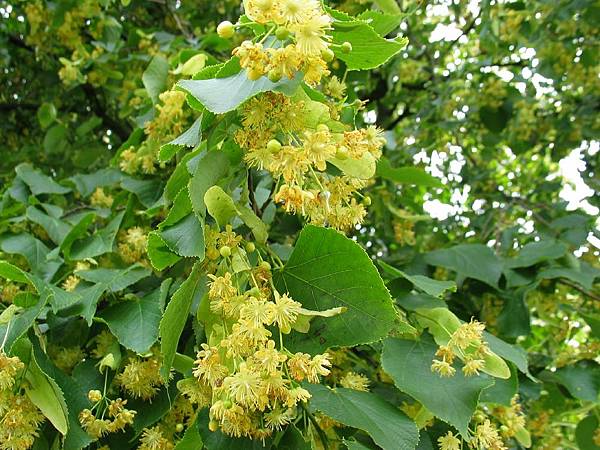菩提花(Linden,Tilia × vulgaris / Tilia × europaea)
錦葵科(Malvaceae)椴樹屬(Tilia)
學名:Tilia × vulgaris / Tilia × europaea
別名:荷蘭椴樹

圖:菩提花(Tilia × vulgaris / Tilia × europaea) [1]
菩提是喜馬拉雅山區原生種,由闊葉椴(Tilia platyphyllos)和小葉椴(Tilia cordata)雜交的品種,從開花到花謝僅4天,整個花期約16天[2-4]。花茶的風味取決於單寧酸和花黏液的比率,2%以上的單寧酸和低黏液量比較好喝,闊葉椴、小葉椴和菩提花是較受歡迎的幾個品種[5]。
【生理活性】
菩提花50%甲醇萃取物含有(-)-表兒茶素((-)-epicatechin,1.9-4.2 μg/mg乾重)、原矢車菊素三聚體(procyanidin trimer,1.9-3.3 μg/mg乾重)、原矢車菊素B2 (procyanidin B2,1.8-3.1 μg/mg乾重)、epicatechin-(4β→8)-epicatechin-(4β→8)-epicatechin-(4β→8)-epicatechin (1.6-3.2 μg/mg乾重)、異槲皮素(isoquercetin,1.0-2.7 μg/mg乾重)[6]。
民俗療法
土耳其人當作利尿劑、抗憂鬱和感冒藥[7]。菩提花茶、蒸餾液治癲癇,煎煮液有鎮靜作用[8-9]。葉片有緩解膀胱炎和排尿灼熱感之效[10]。歐洲多國藥典都表示菩提花能有效緩解多種感冒症狀[5]。菩提花做為傳統草藥描述療效時,這裡的菩提花可能是指闊葉椴、小葉椴或菩提花,或是它們彼此間的混合物[5]。
花本身富含黏液,它能舒緩神經、壓力、焦慮、失眠和歇斯底里,以及感冒、鼻塞、喉嚨刺激、頭痛、竇性頭痛、偏頭痛,也治心悸、高血壓、失禁、肝炎、結腸炎、風濕、出血、下肢膿腫,也能利尿和抗痙攣。精油有檸檬醛(citral)、香茅醛(citronellal)、香茅醇(citronellol)、丁香油酚(eugenol)和檸烯(limonene)。德國藥典描述菩提花為感冒和鎮咳藥的成分之一,也作為泌尿或鎮靜藥。德國小兒科治流感的發汗藥由苦橙皮、白柳樹皮、繡線菊、洋甘菊和菩提花配製而成。[11]
抗氧化
印度菩提的80%甲醇萃取物,樹皮、葉片、果實的總多酚含量分別為9.8、2.9、1.4 mg GAE/g fresh weight;類黃酮總量為1.1、2.3、1.4 mg QE/g fresh weight[3]。
土耳其菩提花的甲醇萃取物、浸漬液和煎煮液,所含的總多酚含量別是107.0、32.4和33.5 mg GAE/g乾重,優於其他香草,例如:大茴香(Pimpinella anisum)、月桂(Laurus nobilis)、巴西里(Petroselinum crispum)、狹葉番瀉(Cassia angustifolia)等[12]。在磷鉬酸銨(phosphomolybdenum)和DPPH˙的抗氧化評估,也是幾個香草中最高。
鎮靜
葡萄牙菩提花熱水萃取物腹腔注射劑量25-100 mg/kg的小鼠在高架十字迷宮(elevated plus maze anxiety test)焦慮實驗模型中[13],雖然靜止不動時間,此焦慮指標增加,但其他表現焦慮的動作時間下降,整體明顯有鎮靜效果。
鎮靜主要由GABAA受體(GABA/benzodiazepine/chloride ionophore receptor complex)調節,毒蕈胺(muscimol)能有效結合GABAA受體,增加氯離子通道透性,抑制神經,造成鎮靜。體外研究顯示[14],菩提花熱水萃取物可與毒蕈胺競爭,直接和GABAA受體結合,產生鎮靜催眠功效。當3者共同培養時,毒蕈胺結合GABAA受體的能力顯著衰退。分析結果指出水萃物含多種胺基酸以及GABA (約 100 mM),或許也有類似苯二氮平類(benzodiazepine)的安眠藥成分,而有能力競爭結合GABAA受體。
抗瘧疾
包含木瓜(Carica papaya)、印度苦楝(Azadirachta indica)、腰果(Anacardium occidentale)、菩提花、檸檬草(Cymbopogan citrates)、芒果(Magnifera indica)、芭樂(Psidium guava)的煎煮液,奈及利亞人每日3次每次300ml持續4-7天,能有效治療瘧疾和氯化奎寧(chloroquine)抗藥性的瘧疾[15]。
可能風險
菩提花做為傳統草藥史至少30年,是美國FDA的“公認安全物質”,也是歐盟清單上的天然來源食品調味香料[5]。
【芳療功效】
1.5g乾燥菩提花使用150ml沸水沖泡的菩提花茶,成人建議攝取量每天2-4次;4-12歲小孩改用1g乾燥菩提花,也是2-4次;4歲以下則無相關紀錄。感冒治療應在初見症狀時就立即開始[5]。
參考資料:
(1)https://www.bomengids.nl/uk/soorten/Hollandse_linde__Tilia_x_vulgaris__Common_linden.html
(2)Weryszko-Chmielewska, E., & Sadowska, D. A. (2010). The phenology of flowering and pollen release in four species of linden (Tilia L.). Journal of Apicultural Science, 54(2), 99-108.
(3)Sharma, R. K., Sharma, N., Kumar, U., & Samant, S. S. (2021). Antioxidant properties, phenolics and flavonoids content of some economically important plants from North-west Indian Himalaya. Natural Product Research, 1-5.
(4)Sarvašová, I., & Ďurkovič, J. (2002). In vitro regeneration of European linden. Biologia plantarum, 45(1), 149-152.
(5)European Medicines Agency. (2012). Assessment report on Tilia cordata Miller, Tilia platyphyllos Scop., Tilia x vulgaris Heyne or their mixtures, flos.
(6)Ziaja, M., Pawłowska, K. A., Józefczyk, K., Pruś, A., Stefańska, J., & Granica, S. (2020). UHPLC-DAD-MS/MS analysis of extracts from linden flowers (Tiliae flos): Differences in the chemical composition between five Tilia species growing in Europe. Industrial Crops and Products, 154, 112691.
(7)Başgel, S., & Erdemoğlu, S. B. (2006). Determination of mineral and trace elements in some medicinal herbs and their infusions consumed in Turkey. Science of the total environment, 359(1-3), 82-89.
(8)Jäger, A. K., Gauguin, B., Andersen, J., Adsersen, A., & Gudiksen, L. (2013). Screening of plants used in Danish folk medicine to treat depression and anxiety for affinity to the serotonin transporter and inhibition of MAO-A. Journal of ethnopharmacology, 145(3), 822-825.
(9)Jäger, A. K., Gauguin, B., Adsersen, A., & Gudiksen, L. (2006). Screening of plants used in Danish folk medicine to treat epilepsy and convulsions. Journal of ethnopharmacology, 105(1-2), 294-300.
(10)Radford, A. P. (1966). Brook's Family Herbal. Bristol Medico-Chirurgical Journal, 81(3), 55.
(11)Rodriguez-Fragoso, L., Reyes-Esparza, J., Burchiel, S. W., Herrera-Ruiz, D., & Torres, E. (2008). Risks and benefits of commonly used herbal medicines in Mexico. Toxicology and applied pharmacology, 227(1), 125-135.
(12)Albayrak, S., Aksoy, A., Sagdic, O., & Albayrak, S. (2012). Antioxidant and antimicrobial activities of different extracts of some medicinal herbs consumed as tea and spices in Turkey. Journal of Food Biochemistry, 36(5), 547-554.
(13)Coleta, M., Campos, M. G., Cotrim, M. D., & da Cunha, A. P. (2001). Comparative evaluation of Melissa officinalis L., Tilia europaea L., Passiflora edulis Sims. and Hypericum perforatum L. in the elevated plus maze anxiety test. Pharmacopsychiatry, 34(Sup. 1), 20-21.
(14)Cavadas, C., Fontes Ribeiro, C. A., Santos, M. S., Cunha, A. P., Macedo, T., Caramona, M. M., & Cotrim, M. D. (1997). In vitro study of the interaction of Tilia europeae L. aqueous extract with GABAA receptors in rat brain. Phytotherapy Research, 11(1), 17-21.
(15)Avwioro, G. (2010). Effectiveness of some medicinal plant decoction in the treatment of malaria in Nigeria. Annals of Biological Research, 1(2), 230-237.


 留言列表
留言列表


